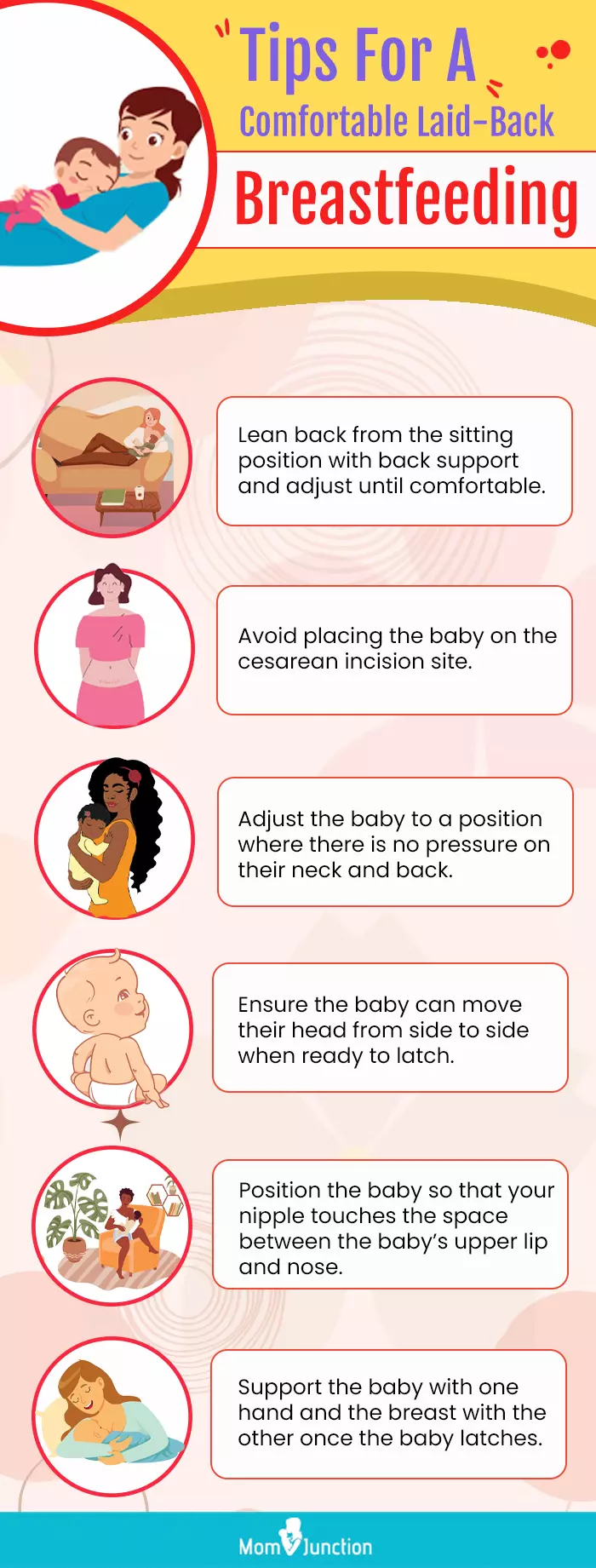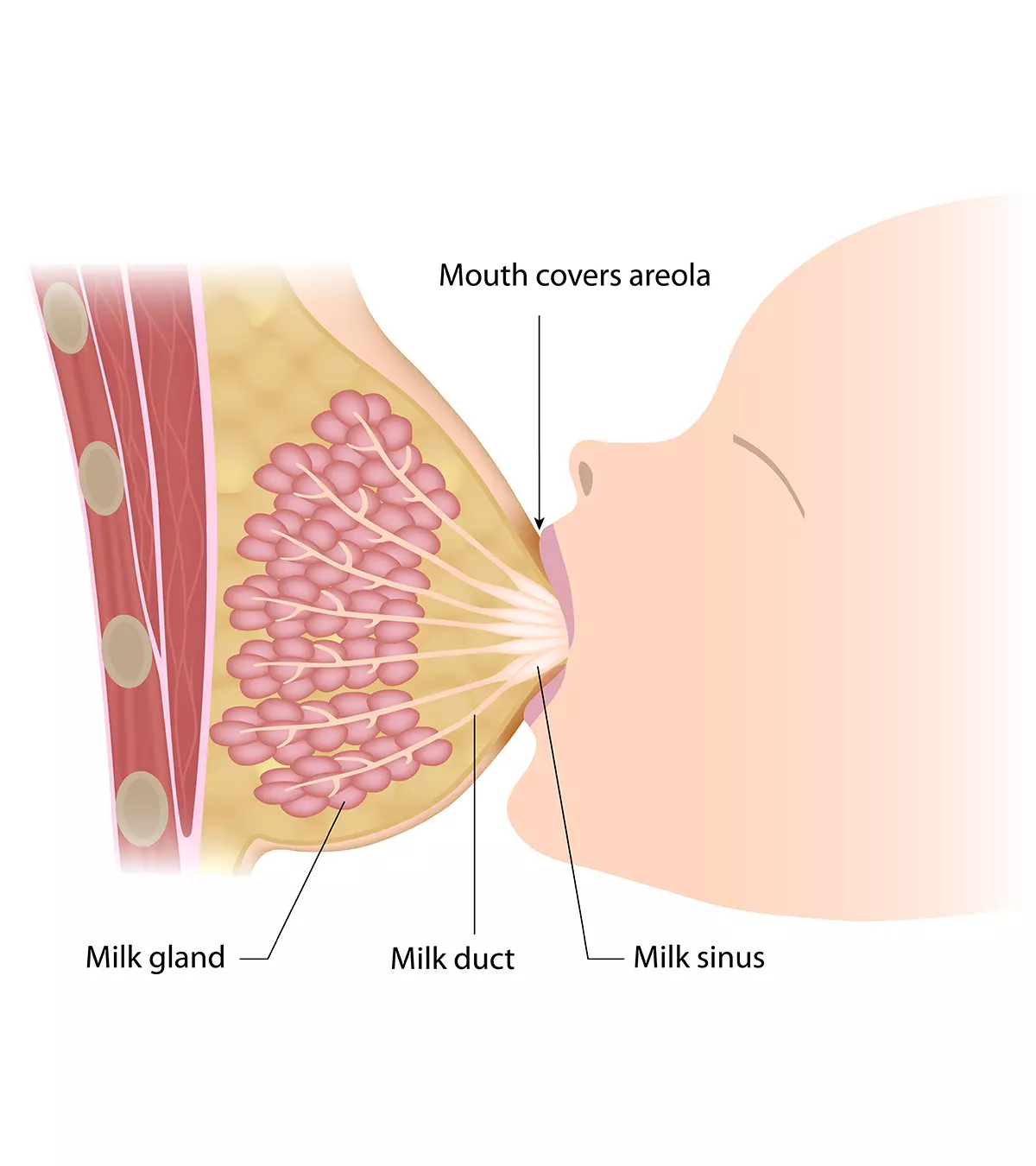
Image: iStock
Laid-back breastfeeding, also referred to as biological nurturing, is a reclined breastfeeding position. This feeding method reportedly stimulates babies’ innate feeding reflexes, which could help them latch accurately. Most women feel that laid-back nursing is an ideal posture while breastfeeding, and this position might help babies who might have latching difficulties. Explore more about the advantages, different approaches, and tips for laid-back breastfeeding in this post.
Key Pointers
- Some benefits of laid-back breastfeeding include bonding and increased production of nurturing hormones.
- Ensure to use back support and comfort yourself, wear comfortable clothing, and give good support to the baby.
- Laid-back breastfeeding allows babies to use primitive feeding reflexes, resulting in a better latch.
- It is a more comfortable position for mothers who’ve undergone C-section delivery.
Benefits Of Laid-back Breastfeeding
Babies can express their instinctive feeding behavior in a laid-back feeding position since their mother’s body supports them. The benefits of laid-back breastfeeding could include the following (1).
- Feeding reflexes of a baby are released during this position.
- Learn breastfeeding together; this position helps newborns and mothers become comfortable with breastfeeding gradually.
- It helps increase the production of nurturing hormones, such as oxytociniA hormone secreted by the pituitary gland to stimulate contractions during childbirth and lactation , in both mother and baby to enhance bonding.
- Babies are well-supported on the mother’s body during laid-back feeding.
- Gravity may also encourage a deeper, more comfortable latch in this position, especially if you are breastfeeding with big breasts.
- Wearing no clothing can increase skin-to-skin contact during this feeding position.

- Mothers can keep the baby in a laid-back position beyond nursing, thus enhancing the bonding between mother and baby.
You may try and use a laid-back nursing position any time unless contraindicated by your lactation consultant or pediatrician.
 Quick fact
Quick factHow To Breastfeed In A Laid-Back Position
The following tips could help you breastfeed comfortably in a laid-back position and ensure a proper latch (2)(3).
- Lean back from sitting position with back support.
- Try to adjust the position until you are comfortable.
- Keep the infant close to support their body.
- Avoid keeping the baby on the incision site if you had a C-section.
- Adjust the baby’s position so that there is no pressure on their neck and back.

- Try to wear comfortable clothing for nursing.
- Babies move their heads from side to side with a wide mouth when they are ready to latch. Positioning the baby so that the mother’s nipple touches the space between their upper lip and nose will trigger the gape reflexiA baby's natural reflex to open their mouth wide when their chin or lip is touched, aiding in a deep latch for breastfeeding , which will encourage a deep and comfortable latch.
- Mothers who have oversupply may try this position.
- If needed, support the baby with one hand and breast with another hand.
- Consider using a feeding pillow or cushion to offer extra support for your back and arms, improving comfort during nursing sessions.
You can breastfeed in this position in each breastfeeding session.
How Does A Newborn Latch During Laid-back Breastfeeding?
This position enhances a baby’s ability to use their primitive feeding reflexes. The baby tries to wriggle, push their feet, and move their head side to side to reach nipples. It ultimately leads to improved reach and better latch to the breast, providing a comfortable nursing experience for both mother and infant. This technique also minimizes nipple pain and allows the baby to rely on their natural instincts for a proper latch, promoting a positive breastfeeding experience (4).
Laid-back breastfeeding is the preferred breastfeeding position for many new mothers during the first few hours after birth. This feeding position also enhances skin contact, which facilitates better mother-child bonding.
 Research finds
Research findsLaid-back Breastfeeding After A Cesarean-section

Mothers who underwent C-section delivery can consider laid-back breastfeeding. It can be convenient after a cesarean section since mothers can sit in a comfortable position with back support (1). A clinical trial examined the effectiveness of laid-back breastfeeding and side-lying breastfeeding positions in mothers recovering from C-sections. The results showed no major differences in breastfeeding success between the two methods, indicating that the laid-back position can serve as a suitable option for these mothers (5).
You can continue to feed the infant at home in a laid-back position if you find upright feeding positions uncomfortable. If you have difficulties moving and placing your baby in the initial days, you may take the help of a nurse, partner, or family member. This semi-reclined position is quite helpful after C-section since it helps the mother avoid pressure on their belly while also letting the baby latch correctly.
How To Do Laid-back Breastfeeding In Public?
You may try the laid-back nursing position in public if you have access to a sofa or a deep chair. More comfortable variation of this position would be Koala hold, where the baby sits straddling the thighs of the mother and lays along her belly, latching onto the breast in a semi-seated position (and she usually will also recline herself as much as possible).
Many restaurants and coffee shops have seating suitable for reclined positions. However, make sure the chair or sofa is sturdy, and you are able to get into a laid-back position without straining yourself. Loose outdoor clothing or a nursing bra could make it easier for your baby to access the breast while breastfeeding.
Frequently Asked Questions
1. What supplies do I need to practice laid-back breastfeeding?
Though no special supplies are required for laid-back breastfeeding, you may consider having comfortable seating, with cushions and pillows to support your neck and back. Other usual supplies may include a nursing bra, blankets, burp cloths, and nipple cream.
2. Are there any risks associated with laid-back breastfeeding?
There are no reported risks associated with laid-back breastfeeding. However, there may be a possibility of the mother falling asleep in a relaxed position. Falling asleep with your baby on a sofa or armchair may increase the risk of sudden infant death syndrome (6). According to a survey by The Lullaby Trust, which included over 3,400 new parents, more than 40% reported unintentionally falling asleep on a sofa or armchair with their baby. Research suggests that this sleeping arrangement can significantly heighten the likelihood of sudden infant death syndrome (SIDS), increasing the risk as much as 50 times (7).
3. What is the best way to transition from bottle feeding to laid-back breastfeeding?
While transitioning a baby from bottle to breastfeeding, ensure you have skin-to-skin contact. Have your baby’s elbows, navel, and the insides of both knees touch you, head turned, and cheek against breast, and keep their feet supported with your hand. Try nursing when your baby sleeps in a dimly lit, noise-free environment. Avoid forcing your baby to feed and let them seek out your breasts themselves. Additionally, you may carry your baby in a sling to keep them close between feedings (8).
Laidback breastfeeding is a reclined position of breastfeeding. Mothers can relax on the sofa, chair, or bed while breastfeeding. They can also use feeding pillows to make nursing more comfortable for them and their babies. Innate reflexes stimulate babies to latch, and gravity supports latch in this feeding position. Skin-to-skin contact between the mother and the baby is also improved in this nursing position. Laid-back breastfeeding helps reduce the risk of choking on breastmilk, mainly due to oversupply, and it provides tummy time for babies. You must avoid laid-back breastfeeding if your healthcare provider or lactation consultant restricts it for medical reasons.
Infographic: How To Properly Breastfeed In A Laid-Back Position?
While breastfeeding is a beautiful part of being a mother, it can also come with challenges. The infographic below offers practical advice for achieving a comfortable, laid-back breastfeeding position. While it is most useful for women with cesarean deliveries and milk oversupply, every lactating woman can use this breastfeeding position.

Illustration: Momjunction Design Team
Illustration: Benefits For Laid Back Breastfeeding How To Do And Tips

Image: Dall·E/MomJunction Design Team
References
- What is laid-back breastfeeding or biological nurturing?; NCT (National Childbirth Trust)
- Lie Back and Relax! A Look at Laid-Back Breastfeeding; La Leche League USA
- Positioning; La Leche League International
- Zhi Wang et al.; The effectiveness of the laid-back position on lactation-related nipple problems and comfort: a meta-analysis; NCBI; (2021)
- Puapornpong, Pawin et al.; Comparison of Breastfeeding Outcomes Between Using the Laid-Back and Side-Lying Breastfeeding Positions in Mothers Delivering by Cesarean Section: A Randomized Controlled Trial; NIH; (2017)
- Positioning and attachment; The Health Service Executive, Ireland
- New survey shows 9 in 10 parents co-sleep but less than half know how to reduce the risk of SIDS; The Lullaby Trust
- The Baby Who Doesn’t Nurse; La Leche League International
Community Experiences
Join the conversation and become a part of our nurturing community! Share your stories, experiences, and insights to connect with fellow parents.
Read full bio of Mary Miller
Read full bio of Dr Bisny T. Joseph
Read full bio of Rohit Garoo
Read full bio of Anindita Ghatak
















